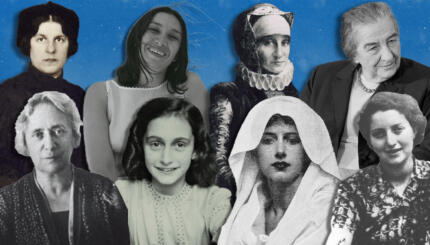Jews read sections of the Torah each week, and these sections, known as parshiyot, inspire endless examination year after year. Each week we we will bring you regular essays examining these portions from a queer perspective, drawn from the book Torah Queeries: Weekly Commentaries on the Hebrew Bible and the Torah Queeries online collection. This week, Alex Weissman examines parashat Re’eh, which contains rules and directions for Temple worship.
This week’s parasha starts with the kind of moralizing binary we are quite accustomed to seeing in Torah. If you do X, great. If you do Y, curses. X and Y are then elaborated in great detail, including instructions on when to worship (
Pesach
,
Shavuot
, and
Sukkot
), how to worship (tithes, votives, sacrifice the firstlings of your herds and flocks), what not to worship (false prophets or dream-givers), and what not to eat.
The name of the parasha, Re’eh, means “See” as the first line begins, “See, this day I set before you blessing and curse” (Deut. 11:26). Here, we are compelled to see the acts, be they blessed or cursed, and to see each other, blessed or cursed, depending on those acts. We are to be mutual observers, holding our communities accountable to the laws of Torah. Like so many commandments, these are designed to make us kadosh – that is, both holy – and set apart.
Essentially, Torah is asking us to draw a line—a line between “good Jews” (those who follow the mitzvot) and “bad Jews” (those who do not). It’s certainly a line people draw all the time today, often in our own lives. How many times have we heard, “Oh, I’m a bad Jew,” from friends or ourselves as we’ve bitten into a bacon cheeseburger, skipped Shabbat services, or forgot to daven. What constitutes good Jew vs. bad Jew may be different for different people, but the very presence of that line is something that has been deeply embedded in our communal psyche. Today, while we may not be sacrificing the firstlings of our herds and flocks anymore, we still draw these lines in different ways, including lines around “good” and “bad” sexual beings.
As we “see” each other in our communities of accountability, what are the lines that we draw for blessings and curses for sexual practices? As queer theorist Leo Bersani reminds us in his book, Homos, “visibility is a precondition of surveillance, disciplinary intervention, and at the limit, gender-cleansing.” Being seen and visible may seem like a desirable goal, but it can also be dangerous.
As queer people, sexual moralizing has been used against us to promote violent systems of transphobia and heterosexism with painful impacts on our bodies, our lives, and our souls. But what happens when we respond to this external moralizing of our community’s sexual practices with a moralizing of our own? All too often we are pressured to represent ourselves reactively in an attempt to paint a sanitized version of our lives that erases the richness of sexual differences we could be proud of. Bersani again cautions us, “[In] our anxiety to convince straight society that we are only some malevolent invention and that we can be, like you, good soldiers, good parents, and good citizens, we seem bent on suicide.” Bersani is concerned that in our reactive desires to appear “respectable,” we risk further erasing the members of our communities who are already at the margins and do not have the ability to appear respectable even if they wanted to.
Imagine a contemporary version of Re’eh that enumerated the dominant sexual morals imposed on LGBTQ people. My guess is we would easily find practices that would place large portions of our communities at those erasable margins: protected vs. unprotected sex, with one partner vs. multiple partners, with a significant other vs. a stranger, in private vs. in public, not in exchange for money vs. in exchange for money, vanilla vs. BDSM, etc. Yet in our sexual lives, many of us engage in, or even desire to engage in, many of these marginalized sexual practices. How do we recognize the pleasures, risks, desires, and differences in our sexual lives in a way that does not buy normalcy at the cost of sacrificing our margins? The answer lies in Talmud.
“As the curse was pronounced by the Levites, so the blessing had to be pronounced by the Levites. As the curse was uttered in a loud voice, so the blessing had to be uttered in a loud voice. As the curse was said in Hebrew, so the blessing had to be said in Hebrew. As the curses were in general and particular terms, so must the blessings be in general and particular terms. And as with the curse both parties respond ‘Amen,’ so with the blessing both parties respond “Amen” (Babylonian Talmud Sotah 37b.).
Blessing and curse are inseparable; if we utter a curse, so must we mutter a blessing. They both come from us in the same ways because we cannot and should not be ashamed of either—we say them both loudly, in Hebrew, and in relationship to others. Given their equal footing in ritual, I want to suggest that the blessing and curse are so intricately bound up with each other that curse and blessing actually bleed into each other so as to become one. In just a few chapters (Deut. 23:3-6), we’ll revisit the story of Balaam, whose curse for the Israelites turned into blessings three separate times! Blessing and curse collapse into each other as the boundaries between them are blurred.
If we see curses and blessings as such, perhaps we can see, as we are commanded, each other as Jews and as sexual beings who are simultaneously worthy of curses/blessings, which are determined not by the shaming practices of moralizing heterosexism, but by communities of righteousness and love who understand that, as Walt Whitman taught us, “I am large, I contain multitudes.”
Re’eh ends on a hopeful (albeit masculinist) note with more instructions on how to worship, “They shall not appear before Adonai empty handed, but each with his own gift, according to the blessing that Adonai your God has bestowed upon you” (Deut. 16:16-17). If our holiness before God is determined “according to blessing that Adonai your god has bestowed upon” us, then God recognizes our holiness to include our curses as well. Let Re’eh be a model for us all to see the blessings, curses, and multitudes that exist within ourselves and each other as we celebrate the complexity of difference in our sexual and religious lives.
Adonai
Pronounced: ah-doe-NYE, Origin: Hebrew, a name for God.
Shabbat
Pronounced: shuh-BAHT or shah-BAHT, Origin: Hebrew, the Sabbath, from sundown Friday to sundown Saturday.
Talmud
Pronounced: TALL-mud, Origin: Hebrew, the set of teachings and commentaries on the Torah that form the basis for Jewish law. Comprised of the Mishnah and the Gemara, it contains the opinions of thousands of rabbis from different periods in Jewish history.
Torah
Pronunced: TORE-uh, Origin: Hebrew, the Five Books of Moses.


